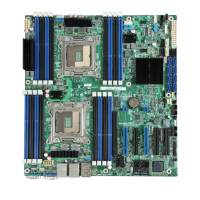Intel
®
Server Board S2600CP and Server System P4000CP TPS
Intel® Server Board S2600CP and Intel® Server System P4000CP Platform Management
Revision 1.1
Intel order number G26942-003
71
Table 21. Standard Channel Assignments
Channel ID Interface Supports
Sessions
0 Primary IPMB No
1 LAN 1
Yes
2 LAN 2
Yes
3 LAN3
1
(Provided by the Intel
®
Dedicated Server Management NIC)
Yes
4 Reserved
Yes
5 USB No
6 Secondary IPMB No
7 SMM No
8 – 0Dh Reserved –
0Eh Self
2
–
0Fh SMS/Receive Message Queue No
Notes:
1. Optional hardware supported by the server system.
2. Refers to the actual channel used to send the request.
6.4.2 User Model
The BMC supports the IPMI 2.0 user model. 15 user IDs are supported. These 15 users can be
assigned to any channel. The following restrictions are placed on user-related operations:
1. User names for User IDs 1 and 2 cannot be changed. These are always “” (Null/blank)
and “root” respectively.
2. User 2 (“root”) always has the administrator privilege level.
3. All user passwords (including passwords for 1 and 2) may be modified.
4. User IDs 3-15 may be used freely, with the condition that user names are unique.
Therefore, no other users can be named “” (Null), “root,” or any other existing user name.
6.4.3 LAN Interface
The BMC implements both the IPMI 1.5 and IPMI 2.0 messaging models. These provide out-of-
band local area network (LAN) communication between the BMC and the network.
Run-time determination of LAN channel capabilities can be determined by both standard IPMI
defined mechanisms.
6.4.3.1 IPMI 1.5 Messaging
The communication protocol packet format consists of IPMI requests and responses
encapsulated in an IPMI session wrapper for authentication, and wrapped in an RMCP packet,
which is wrapped in an IP/UDP packet. Although authentication is provided, no encryption is

